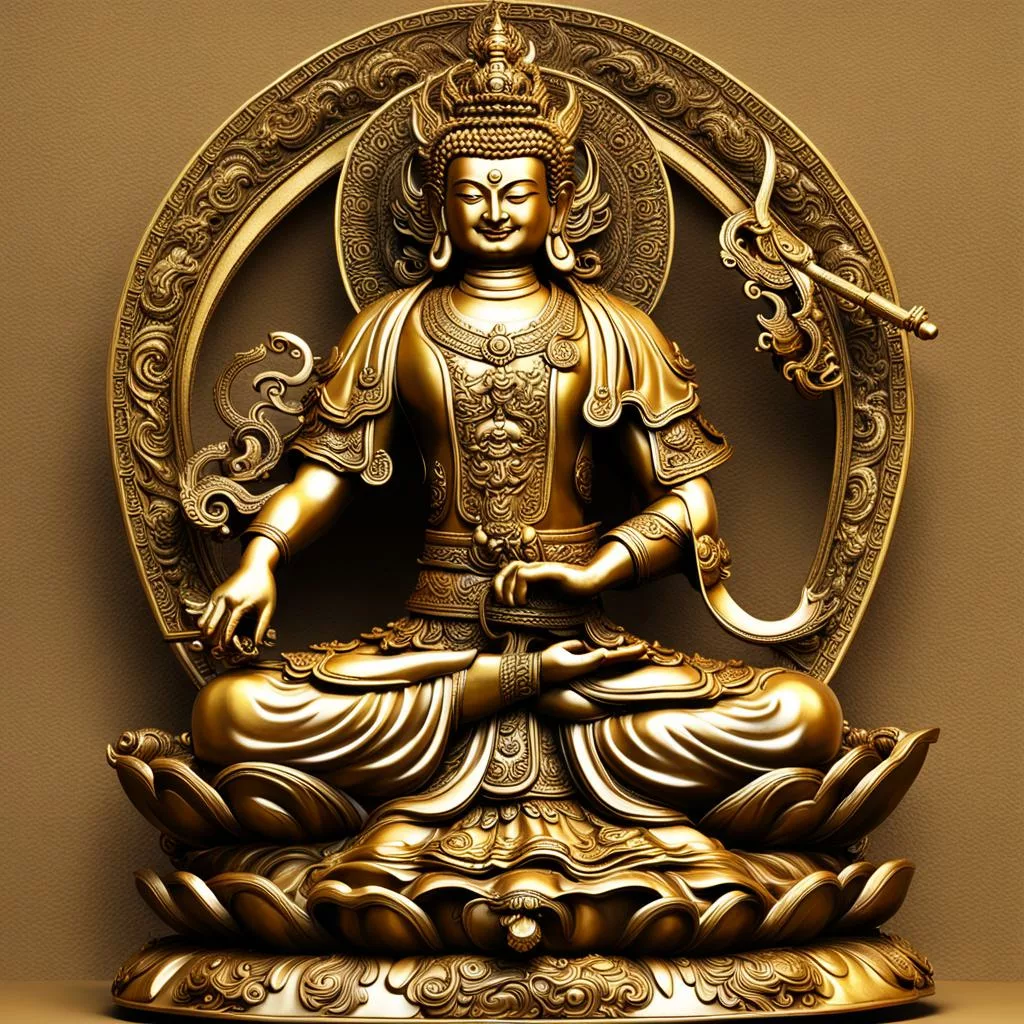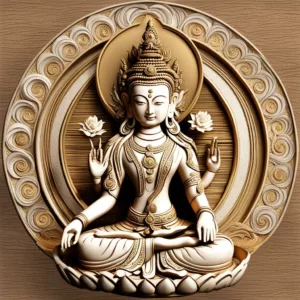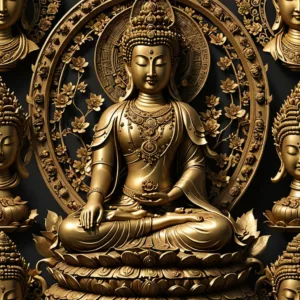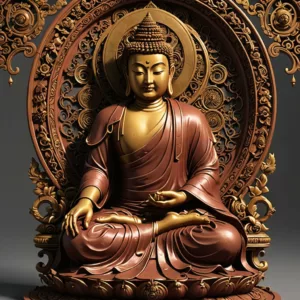
Manjushri is one of the 3 principal bodhisattvas. He is the bodhisattva of wisdom (prajna).
Summary Manjushri
Manjushri Knowledge Graph (Table Format)
| Entity | Description |
|---|---|
| Manjushri | A Bodhisattva associated with wisdom, knowledge, and insight in Mahayana Buddhism. |
| Bodhisattva | An enlightened being who postpones their own nirvana to guide all beings towards liberation. |
| Wisdom | The ability to see things as they truly are, free from illusion and self-deception. |
| Knowledge | The accumulation of information and understanding through learning and experience. |
| Insight | Deep understanding or perception, often gained through meditation or contemplation. |
| Sword | A symbolic attribute of Manjushri, representing the power of wisdom to cut through ignorance and delusion. |
| Lotus Flower | A symbol of purity, enlightenment, and spiritual growth, often depicted as Manjushri’s seat. |
| Mahayana Buddhism | A branch of Buddhism emphasizing the path of the Bodhisattva, where Manjushri is a prominent figure. |
Relationships
| Relationship | Description |
|---|---|
| Embodiment of | Manjushri embodies the qualities of wisdom, knowledge, and insight, serving as a guide and inspiration for practitioners seeking these qualities. |
| Represents | Manjushri’s sword symbolizes the power of wisdom to cut through ignorance and obstacles on the path to enlightenment. |
| Associated with | The lotus flower signifies Manjushri’s purity and his connection to the enlightened mind. |
| Belongs to | Manjushri is a prominent figure within Mahayana Buddhism, particularly revered in traditions like Vajrayana. |
Additional Notes:
- Manjushri is often depicted in various forms, typically holding a sword and a book, representing the cutting away of ignorance and the pursuit of knowledge.
- Mantras and practices associated with Manjushri are believed to help cultivate wisdom, clarity, and understanding.
- Manjushri is considered a celestial Buddha in some Mahayana traditions, representing the embodiment of enlightened wisdom.
This table provides a basic understanding of Manjushri and his significance in Mahayana Buddhism.
Table of Contents
Manjushri, Bodhisattva of Wisdom

Manjushri, also known as Wenshu in Chinese or Monju in Japanese, is considered one of the most significant Bodhisattvas in Mahayana Buddhism. Manjushri is the embodiment of prajñā (transcendent wisdom), and he is often depicted as a youthful figure holding a flaming sword in his right hand, symbolizing his ability to cut through delusion or ignorance.
In his left hand, he holds a lotus flower on which rests the Prajnaparamita Sutra, the scripture that represents the realization of sunyata (emptiness).
Manjushri is often portrayed riding a lion, which symbolizes the taming of the mind, as well as the courage and resolve needed to confront and dispel ignorance. His flaming sword is said to illuminate the world with wisdom, cutting through ignorance and bringing enlightenment to sentient beings.
The Bodhisattva Manjushri is revered and worshipped in many Buddhist countries including Tibet, Nepal, China, Japan and Korea. He is often invoked by Buddhist practitioners seeking wisdom and understanding. His mantra, “Om A Ra Pa Ca Na Dhih,” is chanted to develop wisdom and clarity of thought.
In Vajrayana or Tibetan Buddhism, Manjushri is considered a fully enlightened Buddha who chose to remain in the world in the form of a Bodhisattva to help others achieve enlightenment. He is also considered the master of all the Buddhas and Bodhisattvas, as he is the embodiment of their collective wisdom.
In the context of Buddhist teachings, Manjushri symbolizes the importance of wisdom and intellectual understanding in the path to enlightenment. His iconography and teachings remind us that wisdom is not merely a passive state of knowing, but an active process of cutting through ignorance and delusion.
Manjushri, also known as Manjusri, is a revered bodhisattva in Mahayana Buddhism, embodying the wisdom of enlightenment. As the personification of transcendent wisdom, Manjushri plays a crucial role in guiding practitioners on the path to awakening. The name “Manjushri” translates to “Gentle Glory” or “Sweet Splendor,” reflecting the bodhisattva’s qualities of compassionate wisdom.
Manjushri Mantra
Devotees seeking to invoke the wisdom and blessings of Manjushri often recite the Manjushri mantra. The most well-known mantra associated with Manjushri is:
Om Ah Ra Pa Cha Na Dhih
Chanting this mantra is believed to sharpen one’s intellect, enhance understanding, and invoke the profound wisdom represented by Manjushri. The vibrations of the mantra are thought to awaken the dormant wisdom within practitioners, guiding them towards clarity and insight.
Is Manjushri Male or Female?
Manjushri is traditionally depicted as a male bodhisattva in Buddhist iconography. The male form of Manjushri symbolizes the integration of wisdom with the qualities traditionally associated with masculine energy, such as strength and discernment. However, it is essential to recognize that gender in Buddhist iconography often transcends conventional binary categorizations and is more about symbolic representation.
Manjushri Story
The stories surrounding Manjushri vary across Buddhist traditions, but a common narrative highlights Manjushri’s role in aiding practitioners on their spiritual journey. In one popular story, Manjushri emanated from a lotus flower in the middle of a lake. As he unfolded, his radiance illuminated the entire universe, symbolizing the awakening of wisdom that dispels the darkness of ignorance.
Another well-known narrative describes Manjushri’s encounter with the demon of ignorance. Riding a lion, the symbol of courage, Manjushri engages in a battle with the demon, cutting through the darkness of ignorance with his flaming sword of wisdom. This story illustrates Manjushri’s compassionate intention to free beings from the shackles of ignorance and guide them towards enlightenment.
Manjushri Meaning
The name “Manjushri” carries deep symbolic significance. “Manju” means gentle, kind, or sweet, while “shri” denotes radiance or glory. Together, the name conveys the idea of a gentle and radiant wisdom that brings clarity and illumination. Manjushri’s name reflects the bodhisattva’s compassionate intention to guide beings toward the light of wisdom, dispelling the darkness of ignorance.
Manjushri Origin
Manjushri has roots in early Buddhist scriptures, where the bodhisattva is mentioned in texts like the Prajnaparamita Sutras. Over time, Manjushri’s popularity expanded, becoming a central figure in Mahayana Buddhism. The Lotus Sutra, a foundational text in Mahayana Buddhism, features Manjushri delivering a discourse on the qualities of a Buddha, further establishing the bodhisattva’s importance in the tradition.
Manjushri in Hinduism
While primarily a Buddhist figure, Manjushri has also made appearances in Hinduism. In some Hindu traditions, Manjushri is identified with Saraswati, the goddess of knowledge, music, and the arts. This syncretic approach highlights the fluidity of religious boundaries and the shared reverence for wisdom and knowledge in both traditions.
Manjushri Tibetan
In Tibetan Buddhism, Manjushri, often referred to as Jamyang in Tibetan, holds a significant place. The Dalai Lama is considered an emanation of Manjushri, representing the embodiment of wisdom and compassion in Tibetan Buddhist leadership. The practice of reciting the Manjushri mantra and visualizing the bodhisattva is prevalent in Tibetan Buddhist rituals and meditations.
Manjushri Statue
Manjushri is commonly depicted in Buddhist art and sculptures. The iconic representation of Manjushri includes the bodhisattva holding a flaming sword in the right hand and a lotus flower in the left. The flaming sword symbolizes the cutting through of ignorance, while the lotus represents purity and enlightenment. Manjushri may be seated or standing, exuding an aura of wisdom and compassion.
In Tibetan Buddhist traditions, there is a unique form of Manjushri known as Manjushri Arapachana, distinguished by five Dhyani Buddhas crowning the bodhisattva’s head. This form emphasizes the integration of Manjushri’s wisdom with the enlightened qualities of the Five Buddhas.
The Wisdom Teachings of Manjushri
Manjushri is not merely an external deity to be worshipped but a source of inspiration for cultivating wisdom within oneself. The wisdom teachings associated with Manjushri emphasize the understanding of emptiness, the nature of reality, and the transcendence of dualistic thinking. Practitioners turn to Manjushri for guidance in sharpening their intellect and discernment on the path to enlightenment.
Secrets of Meditation for Anxiety
Like millions of people, you may have suffered from anxiety for years. Meditation, yoga, peaceful music – it never works. It takes too long, and it’s not stable. Why? Because peace is treated as a cause for freedom, but it’s not – it’s the result. The cause to free yourself from anxiety is completely different.
Click now to Overcome Anxiety for good.
Conclusion
Manjushri, the bodhisattva of wisdom, holds a central role in Mahayana Buddhism, inspiring countless practitioners on their spiritual journey. The Manjushri mantra, stories, meaning, and depictions in art all contribute to the rich tapestry of this bodhisattva’s significance. As a guide on the path to enlightenment, Manjushri’s wisdom illuminates the darkness of ignorance, fostering clarity, understanding, and compassionate discernment. In invoking the wisdom of Manjushri, practitioners seek not only intellectual acuity but a profound transformation that leads to the awakening of the enlightened mind.

May all beings be happy
May all beings be peaceful
May all beings be safe
May all beings awaken to the light of their true nature
May all beings be free








